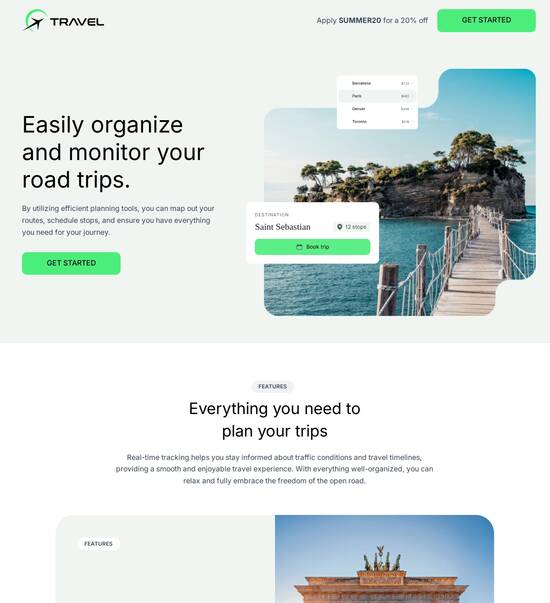
HTML page template with interactive political poll
Explore Similar TemplatesAbout template
Use HTML page templates with interactive political poll and make your communications easy and transparent. Try our solution today.
Recommended templates

Easy to build without coding
With the intuitive drag-and-drop builder, anyone on your team can create high-converting pages without any knowledge of code or design. Make enhancements to your landing page with custom widgets using Javascript, HTML/CSS, or third-party scripts.

Multiple layouts for any industry and goal
Select from 500+ landing page layouts built to boost conversions across industry-specific scenarios. Customize them by adjusting fonts, adding images, and generating on-brand content with the AI assistant. Quickly scale with Instablocks® and Global Blocks that you can save, reuse, and update globally.

Loads fast and looks polished on any device
Every template is responsive, which means they present professionally on any device and load blazingly fast with our Thor Render Engine. You can also power them up with Google AMP technology to deliver an unparalleled mobile experience and drive higher conversions.

Robust analytics & experimentation
Get real-time updates and reporting across all your devices, showing the number of visitors, conversions, cost-per-visitor, and cost-per-lead. Launch AI-powered experiments, run A/B tests, and use heatmaps to analyze user behavior, then optimize your landing page to maximize conversions.







Easy to build without coding
With the intuitive drag-and-drop builder, anyone on your team can create high-converting pages without any knowledge of code or design. Make enhancements to your landing page with custom widgets using Javascript, HTML/CSS, or third-party scripts.
Multiple layouts for any industry and goal
Select from 500+ landing page layouts built to boost conversions across industry-specific scenarios. Customize them by adjusting fonts, adding images, and generating on-brand content with the AI assistant. Quickly scale with Instablocks® and Global Blocks that you can save, reuse, and update globally.
Loads fast and looks polished on any device
Every template is responsive, which means they present professionally on any device and load blazingly fast with our Thor Render Engine.
Robust analytics & experimentation
Get real-time updates and reporting across all your devices, showing the number of visitors, conversions, cost-per-visitor, and cost-per-lead. Launch AI-powered experiments, run A/B tests, and use heatmaps to analyze user behavior, then optimize your landing page to maximize conversions.
All the features you need to build exit poll template
Explore more featuresLearn how to build html poll
Frequently asked questions about poll templates
Leading the way in building high-performing landing pages





Voting website template: Your ultimate how-to guide
Instapage's landing page and conversion rate optimization (CRO) platform offers marketers the essential tools to enhance their digital campaigns significantly. With an extensive library of high-converting templates and personalization features, creating a compelling landing page that meets your audience's needs has never been easier.
Understanding the advantages of Instapage's features
Instapage empowers businesses from various verticals, including marketing, education, and financial services, to accelerate their campaigns efficiently. By using ready-to-use templates and lead generation elements, marketers can quickly construct attractive landing pages that effectively capture leads. The intuitive interface eliminates the need for coding knowledge, making it accessible for teams of any size.
- High-Converting Templates: Access over 100 professionally designed templates tailored for various marketing campaigns and goals.
- Lead Generation Elements: Utilize pre-built forms and call-to-action buttons to enhance lead capture without excessive manual effort.
- User-Friendly Interface: The drag-and-drop builder allows users to create landing pages swiftly, enhancing productivity.
Step 1: Building your landing page effortlessly
The first step in leveraging Instapage is to select and customize a landing page template that aligns with your campaign objectives. Here's a guide to get started:
- Choose a Template: Browse through the extensive template library to find one that resonates with your target audience.
- Customize Content: Utilize Instablocks to rearrange elements and make your page visually engaging with compelling copy and images.
- Preview and Publish: Ensure everything looks perfect by using the preview feature before launching your landing page.
Step 2: Optimize for maximum conversion rates
Once your landing page is live, optimizing for conversions is crucial. Instapage offers built-in experimentation capabilities that allow you to analyze user behavior.
- A/B Testing: Experiment with different headlines, images, and call-to-action placements to determine what resonates best with your audience.
- Heatmaps: Analyze visitor interactions on your page with heatmaps to understand how they engage with your content.
- Analytics Dashboard: Track metrics such as bounce rates, conversion rates, and user engagement to enhance your strategies continually.
Step 3: Personalizing your landing pages
To effectively capture and convert leads, personalized content is key. Instapage makes it easy to deliver tailored experiences for different audience segments.
- Dynamic Text Replacement: Customize content dynamically based on visitor data to increase relevance.
- AdMap Integration: Align specific advertisements with tailored landing pages to improve conversion rates.
- Audience-Level Tracking: Use detailed analytics tools to monitor the performance of distinct audience segments.
In conclusion, Instapage stands out as an all-in-one solution for marketers looking to enhance their digital campaign outcomes through effective landing page creation and optimization. Leveraging its features can significantly enhance your ROI.
Ready to supercharge your marketing efforts? Start exploring Instapage today and see how easy it is to create high-converting landing pages tailored for your audience.
People also ask about html poll template
Creating an HTML page template with interactive political polls
Understanding the need for interactive elements in political campaigns
In recent years, political engagement has witnessed a significant transformation, ushering in a demand for interactive elements that encourage citizen participation. Voter engagement strategies are evolving, with an increasing emphasis on capturing public opinion through tools such as interactive polls. Campaigns that effectively leverage these mechanisms can build a more authentic dialogue with their constituents.
One of the critical factors driving this evolution is the increasing demand for citizen feedback. Voters are more informed and active than ever, seeking to express their views and influence decisions. Interactive polls provide a platform for this feedback, shining a light on public sentiment regarding pressing issues, helping candidates gauge where they stand within their communities.
Moreover, real-time data gathering is vital for informed decision-making in political campaigns. By collecting and analyzing polling data, campaigns can adjust their messaging, strategies, and outreach efforts based on the latest public opinions. This data-driven approach not only informs political strategies but also fosters a sense of community involvement.
Understanding the evolving landscape of voter engagement is crucial.
Interactive polls serve as a catalyst for meaningful dialogue.
Real-time data acquisition is essential for responsive strategies.
Features of an HTML page template for interactive political polls
An effective HTML page template for interactive political polls is characterized by intuitive design and robust functionalities. Firstly, a streamlined user interface is paramount for encouraging participation. Users should be able to navigate the poll effortlessly and contribute their opinions without confusion, ensuring that the experience is as smooth as possible.
Visual elements play a critical role in enhancing user engagement. Incorporating eye-catching graphics or animations can draw attention to the poll and encourage participation, especially among younger demographics. Furthermore, customizable poll widgets are invaluable. They allow campaigns to select from various formats, whether single-choice, multiple-choice, or ranking options, creating polls that cater specifically to their audience.
Moreover, aligning the poll’s visual elements with campaign branding establishes continuity across marketing channels. The capacity for real-time data capturing ensures that users receive instant feedback on their participation. After voting, respondents should be able to see aggregated results, fostering engagement and reflecting transparency in the polling process.
Intuitive user interfaces enhance participant experience.
Customizable poll formats allow for tailored engagement.
Real-time data capturing offers instant feedback to participants.
Step-by-step guide to creating an interactive poll web page
Creating an interactive poll web page begins with setting up the basic structure. The choice of website platform has significant implications for the deployment of your poll. Content Management Systems (CMS) like WordPress, Wix, or specialized polling platforms can facilitate effective implementation with less time and effort. It’s beneficial to choose a platform that balances flexibility with user-friendliness.
Next, utilizing HTML templates for swift deployment can expedite the process. Available templates are often designed with user experience in mind, enabling quick modification for unique campaign needs. Integrating the interactive poll widget is the next crucial step. When selecting poll options, consider effectiveness—what type of questions will yield valuable insights? Configuring widget settings and determining placements on the webpage can significantly influence response rates.
Another vital aspect is designing the user experience around the poll. Make sure the poll is optimized for mobile responsiveness, as many users will access it via smartphones and tablets. Employ design principles that promote interaction, such as utilizing contrasting colors for call-to-action buttons, ensuring visibility, and guiding users through the polling process.
Choose the appropriate CMS for your needs.
Utilize HTML templates for quick deployment.
Optimize the poll for mobile devices to maximize engagement.
Enhancing user interaction with dynamic features
Enhancing user interaction is crucial to the effectiveness of interactive polls. Incorporating feedback mechanisms can greatly enrich the user experience. For instance, allowing users to comment on poll options adds a layer of engagement, providing qualitative data beyond mere voting. This commentary not only informs campaign strategies but also fosters a community around the issues at hand.
Another dynamic feature is displaying instant results after participation. Participants appreciate seeing the outcome of their involvement, which reinforces their sense of contribution. This transparency can boost trust and encourage repeat participations in future polls.
Utilizing extensions and tools can elevate poll management capabilities. Various analytics tools are available that can seamlessly track user engagement and visualize results. These tools can offer insights into audience behavior and preferences, facilitating data-driven campaign strategies. Additionally, plugins that enhance polling capabilities can add further customization and interaction options, making your polls stand out.
Allow audience comments for richer user feedback.
Show instant results to boost trust and engagement.
Implement analytics tools to gather insights from polling data.
Analyzing poll results: turning data into actionable insights
After conducting polls, the next critical step is analyzing the results to extract actionable insights. Employing analytical tools allows campaign teams to track user engagement effectively. These tools can reveal which demographics are responding most actively and help identify common sentiments among varying voter groups.
Best practices for tracking user engagement include setting clear KPIs before launching polls. Metrics such as participation rate, completion time, and user comments can provide greater context to the raw voting data. Mapping sentiment through patterns of results enables campaigns to gauge where public opinion stands on pressing issues, serving as a vital touch point for strategy adjustments.
Interpreting data for campaign strategy is the next logical step. Correlating poll data with voter demographics highlights how specific groups view issues differently. This can inform tailored messaging that resonates more profoundly with distinct segments, boosting the campaign's effectiveness.
Set clear KPIs for tracking user engagement before launching polls.
Use analytical tools to extract and visualize data insights.
Tailor messaging based on demographic insights gathered from polls.
Promoting the interactive poll across digital channels
Effective promotion of the interactive poll is essential for maximizing participation. Strategic placement on the homepage and blog pages ensures visibility. Best practices dictate that polls should be embedded in key areas where users are likely to engage. A compelling call-to-action should accompany the poll, encouraging visitors to participate and share their views.
Driving traffic through poll placements can significantly enhance engagement rates. Sharing polls in newsletters, email campaigns, or relevant content can boost participation and ensure that diverse audiences can weigh in. The visibility and perceived relevance of the poll can evoke increased interest from casual visitors.
Leveraging social media offers an avenue for broader reach. Creating shareable content around poll results, including infographics or highlights of key findings, prompts users to participate and encourages sharing. Promoting polls across various social platforms, with tailored messaging for each audience, can drastically increase the spread of the poll and invigorate discussions among followers.
Embed polls in high-traffic areas of your website.
Utilize social media to promote polls and encourage sharing.
Implement compelling calls-to-action to boost participation.
Real-world examples of successful political polls
Examining real-world examples of successful political polls provides valuable insights into effective implementations. Case studies of notable campaigns often highlight measurable outcomes—such as increased community engagement, improved messaging, and enhanced voter turnout—that stem from leveraging interactive tools. Analyzing these outcomes can inform best practices for future campaigns, enabling teams to refine their approaches.
Conversely, learning from failures is equally important. What went wrong in less successful campaigns? A closer examination can reveal pitfalls, such as poorly designed polls that confused voters or ineffective promotions that failed to reach target groups. Understanding these lessons fosters a more robust strategy moving forward.
Interviews with campaign managers who have successfully integrated polls can provide deeper insights. Such discussions might unveil innovative techniques employed to boost participation and effectively utilize data gained from polling results. As interactive polling continues to evolve, predictions from these professionals can shed light on future trends in political engagement.
Analyze successful implementations for valuable insights.
Learn from campaign failures to avoid pitfalls.
Gather insights from experienced campaign managers on future trends.
Overcoming challenges in implementing interactive polls
While the potential benefits of interactive polls are substantial, overcoming the challenges associated with their implementation is critical. Data security and privacy compliance must be prioritized to safeguard user information. With growing concerns surrounding data breaches, ensuring compliance with regulations such as GDPR or CCPA is not just a legal imperative but also an essential aspect of building user trust.
Tools available for monitoring compliance and enhancing transparency can streamline this process. Such tools help ensure that users feel secure in their interactions, increasing the likelihood of participation. Addressing user concerns and hesitations also plays a crucial role. This can include educational resources, such as FAQs or tutorials, that clarify how data will be used and explain the polling process.
Building trust through transparent practices can alleviate doubts among potential participants. Engaging with users and creating opportunities for questions or feedback fosters a welcoming environment, ultimately enhancing engagement with the interactive poll.
Prioritize data security to build user trust.
Utilize compliance monitoring tools to ensure transparency.
Provide educational resources to clarify usage and gain participation.
Future trends in interactive political polling
The landscape of interactive political polling is on the cusp of several transformative trends, driven by advancements in technology. The rise of AI and machine learning brings forth predictive analytics that can enhance voter insights. This technology can process vast amounts of data to identify patterns, allowing campaigns to tailor their interactions and outreach effectively based on predicted voter behavior.
As technology continues to evolve, the possibility of integrating augmented reality (AR) and immersive experiences in political engagement may soon become a reality. With these technologies, voters could interact with polls in more engaging ways, potentially transforming how public sentiment is gauged. The shift towards participatory democratic processes through technology signifies an exciting future for interactive political polling.
Ultimately, campaigns that stay ahead of these trends can benefit significantly. Embracing these technologies not only establishes a forward-thinking image but also fosters deeper engagement with voters, facilitating a more responsive democratic process.
AI and machine learning to enhance voter insights.
Integrating AR for immersive polling experiences.
Adopting innovative technologies for better voter engagement.
Ready to skyrocket conversions?
Supercharge your ad campaigns with high-performing landing pages
Get started














